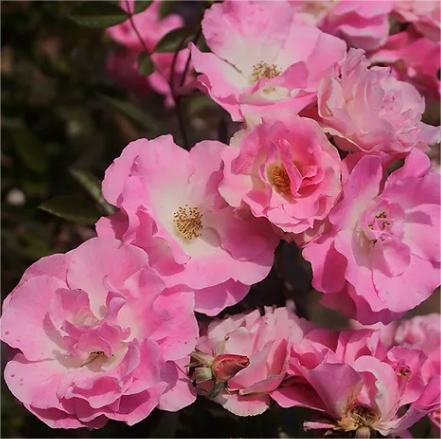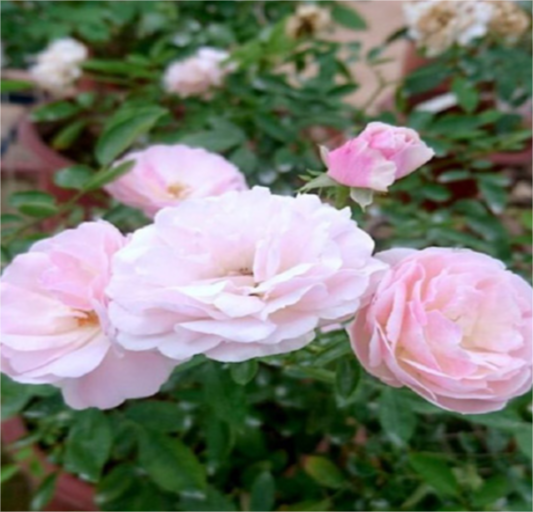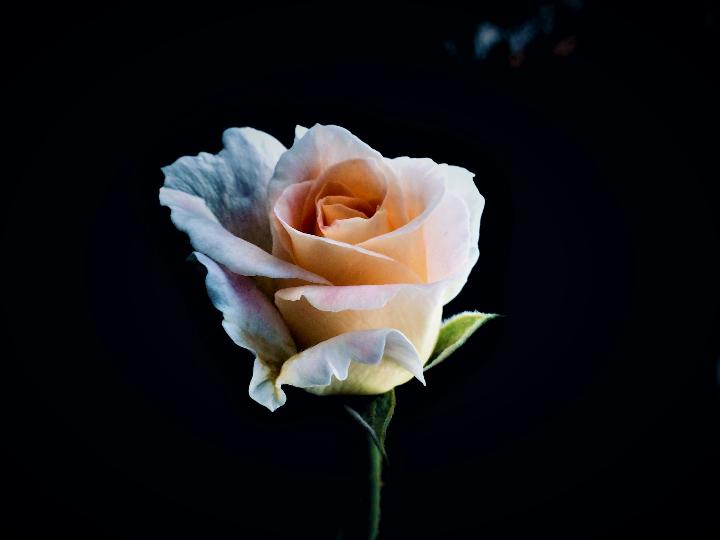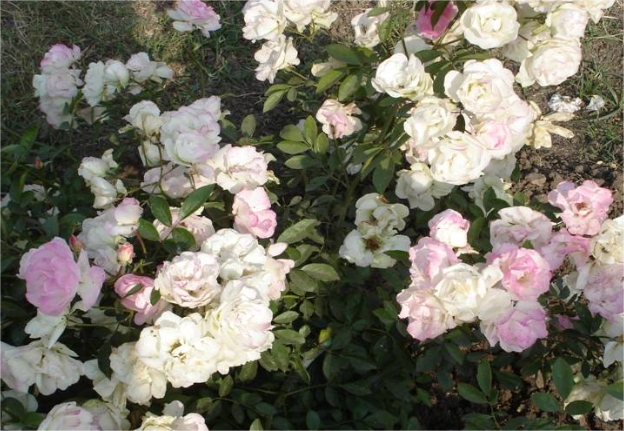Ahalya Rose Plant
Roses, beloved for their beauty, prefer well-drained soil and full sun. With a moderate growth rate, they are hardy in zones 4-9. While not typically consumed, roses have various cultural and aesthetic uses.

Habit
Shrub
Height
2-10 ft
Growth
Moderate
Soil
Well Drained
Shade
Full Sun
Moisture
Moderate
Edible
Yes
Medicinal
No
Origin
India
Climatic Condition
Tropical, Humid
Temperature (°)
20-30°C
Humidity (%)
50-70%
Potting media
Peat+Vermiculite
Fertilizers
Balanced NPK(10:10:10)
Watering
Moderate, Keep Moist
Plant Weight
400-600 g
Flowering Time
Summer to Fall
Soil Ph level
6.0-6.5
Water Ph level
6.5-7.0
Soil EC
1-2 dS/m
Yield Per Plant
100-200 flowers
NPK ratio
20:20:20
life Span
2-3 yrs
Health Benefits
Suggested Grow Media or Potting Mix ?
50% loam, 25% compost, 25% sand
Suggested Fertigation/Fertilizers
Fertilize every 2-3 weeks with a balanced fertilizer.
Common Diseases and Remedies
Black Spot, Powdery Mildew
Black spots on leaves, white powdery substance, distorted growth
Neem oil, garlic spray
HEALTH BENEFITS
Ahalya Rose, also known as Ahalya rose or Ahalya Rose extract, is often used for its potential health benefits, particularly in traditional practices. Some of the potential benefits of Ahalya Rose, mainly attributed to its petals or essential oil, include:
- Anti-inflammatory properties: The rose extract may help in reducing inflammation, which can benefit conditions like arthritis or general body aches.
- Antioxidant effects: Ahalya Rose is rich in antioxidants, which can help neutralize free radicals in the body and prevent oxidative stress, potentially improving overall health and slowing aging.
- Skin health: Rose extracts, including Ahalya Rose, are commonly used in skincare for their hydrating, soothing, and anti-aging properties. They can help with conditions like acne, dry skin, or irritation.
- Mood enhancement: The scent of Ahalya Rose, similar to other types of roses, is known for its calming effect. It can help reduce stress and anxiety, promote relaxation, and enhance mood.
- Digestive health: Some believe rose petals can help improve digestion and alleviate symptoms like constipation or bloating.
- Improved circulation: Ahalya Rose may help improve blood circulation, which can support heart health and overall vitality.
These benefits may vary based on how the Ahalya Rose is used (whether in oils, teas, or other preparations), and more scientific research may be needed to support some of these claims. Always consult a healthcare provider before using any herbal remedy for medicinal purposes.
What Is An Ahalya Rose Plant ?
A rose is a flowering plant of the genus Rosa, known for its beauty and scent. They come in many colours and sizes, and have been cherished for their aesthetic and symbolic value for centuries. Roses are used in gardens, floral arrangements, and hold cultural significance, symbolizing emotions such as love and beauty. With various varieties and hybrids, roses are one of the most popular ornamental plants.

What Are The Different Types Of Ahalya Rose Plants?
1. Floribunda Roses
Clusters of flowers, continuous bloom, hardy, various colours.
2. Grandiflora Roses
Large blooms in clusters on tall stems, a mix of hybrid tea and floribundas.
3. David Austin Roses
Combine old garden roses with modern hybrid teas, admired for fragrance and flower form.
4. Knock Out Roses
Disease-resistant, hardy shrub roses with continuous blooming and low-maintenance.
5. Miniature Roses
Compact plants with small blooms, suitable for containers or small gardens.

How to care for Ahalya Rose Plant ?
1. Location
Roses are primarily outdoor plants. They thrive in full sunlight and well-drained soil, and most varieties require a period of winter dormancy. While there are some compact and miniature rose varieties that can be grown indoors as potted plants, the majority of rose varieties are best suited for outdoor cultivation
2. Sunshine
Roses thrive in full sunlight, which typically means at least 6 to 8 hours of direct sunlight per day. The more sunlight they receive, the better they tend to bloom. Choose a planting location that receives morning sunlight, as this helps the foliage dry faster, reducing the risk of fungal diseases. However, roses can tolerate some afternoon shade in hot climates.
3. Soil
Roses prefer well-drained, slightly acidic to neutral soil. Use a rich, loamy mix with organic matter like compost. Ensure good drainage to prevent waterlogging. Amend soil with organic material, and consider soil testing for nutrient balance. Regularly mulch to retain moisture and suppress weeds. Adjust soil pH as needed, aiming for a range of 6.0 to 6.5. Proper soil preparation supports healthy root development and overall rose plant vitality.
4. Hydration
Water roses deeply and consistently, especially during dry periods. Ensure that the soil is well-drained to prevent waterlogged conditions. Water at the base of the plant to keep the foliage dry and reduce the risk of fungal diseases.

5. Nourishment
Ensure the availability of micronutrients like zinc and iron. Use fertilizers or amendments containing these elements if soil tests indicate deficiencies. Nitrogen (N), phosphorus (P), and potassium (K). Each nutrient plays a specific role in plant growth and development. For roses, a balanced fertilizer with a relatively equal NPK ratio, such as 10-10-10 or 14-14-14, is commonly recommended.
6. Issues
Common issues with roses include pest infestations such as aphids, whiteflies, and scale insects, which can be controlled using insecticidal soaps or beneficial insects. Fungal diseases like black spot and powdery mildew may occur, necessitating preventive measures with fungicides. Nutrient deficiencies should be monitored, and fertilization adjusted based on soil tests. Inconsistent watering can lead to problems, so it's essential to water deeply and consistently while avoiding waterlogged conditions.
What are the Benefits of Ahalya Rose Plant ?
Roses are renowned for their beauty and come in a wide array of colours, shapes, and sizes, making them popular choices for gardens, floral arrangements, and decorative landscaping . Some studies suggest that certain compounds in roses may have health benefits. Rose water, derived from petals, is used in various cultures for its potential soothing and anti-inflammatory properties . Roses, when part of a garden, can attract pollinators such as bees and butterflies. They contribute to the overall biodiversity of the environment.

FAQs About Growing Ahalya Rose Plants
1. How much sunlight do roses need?
Roses thrive in full sunlight, requiring at least 6 to 8 hours of direct sunlight per day for optimal growth and blooming.
2. Can I grow roses indoors?
While most roses are outdoor plants, some compact or miniature varieties can be grown indoors with sufficient sunlight and care.
3. What do different rose colours symbolize?
Red roses often symbolize love and passion, while white roses represent purity and innocence. Other colours convey sentiments such as friendship, gratitude, or admiration.
4. How do I fertilize my roses?
Use a balanced fertilizer with a relatively equal NPK ratio, such as 10-10-10 or 14-14-14. Apply in spring before new growth starts and again in late spring or early summer.
5. How do I protect roses from winter damage?
Apply a layer of mulch around the base of the plant and cover roses with burlap during freezing temperatures to protect them from winter damage.